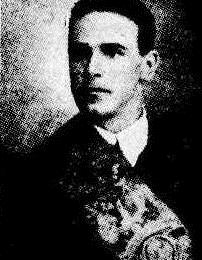Born in Orange in 1887, Harold William Corkett was the youngest son of Jonah and Mary Jane Corkett (nee Jackson). There were eight other children in the family.
Harold attended Orange East Public School and Orange Public School. He developed a keen interest in cycling, was a member of several clubs and was awarded medals on more than one occasion. He also held first aid medals and was an active member of the Ancient Order of Foresters.
Harold’s father, Jonah, died in June 1914, and when war was declared in August that year Harold was one of the first to enlist.
A Private in the 2nd Battalion, Harold embarked from Sydney in October 1914, arriving in Egypt in December.
Private Corkett was wounded during the Gallipoli landing on 25 April 1915, sustaining gunshot wounds to his head. He was transferred to San Stefano Hospital in Alexandria, where he died the following week from his wounds.
Private Harold Corkett is commonly regarded as the first man from Orange to die in WWI, however he was preceded by Herbert Maurice Robertshaw, Eric Martin ‘Dick’ Solling, Charles Herbert Cane and Mathew Aloysius Stackpool.
Three other men from Orange died on 2 May 1915: William Robert Clive Beasley, Oswald Cecil Jeffrey Baylis and William Henry O’Bree.
In May 1915 the mayor of Orange, Ald McNeilly, received a letter containing £1 from a friend of Harold’s, which he asked to be passed on to Harold’s mother. The benefactor requested anonymity, and promised to forward Mrs Corkett 5/- every week. This news was publicised widely throughout Australia.
On 22 May 1915 competitors in the Wellington road cycling race paid their respects to Private Corkett by wearing mourning bands as they competed.
On 28 September 1915 the Ancient Order of Foresters in Orange held a public concert and dance at the Oddfellows’ Hall. Proceeds were donated to William’s mother and the Australian Wounded Fund.
On 25 April 1917 the second ever Anzac Day service in Orange was held at the Orange Public School. Mayoress McNeilly placed a laurel wreath on the Union Jack for each fallen soldier who had attended the school, including Harold William Corkett.
In July 1917 a tree was planted at Orange Public School in Harold’s memory. It was one of 26 trees planted in honour of fallen soldiers who had attended the school.
Harold is also remembered in Newman Park in Orange, where his name appears on a plaque commemorating former Orange East Public School students who were killed in action. He is also commemorated on the Ancient Order of Foresters Orange Roll of Honor and the Holy Trinity Church Orange Honour Roll.
Harold’s name appears on the World War I Roll of Honour on the southern face of the Orange Cenotaph.
In 1923 the Anzac Memorial Avenue of trees was planted along Bathurst Road to commemorate fallen WWI soldiers. A tree was planted in honour of “Pte HW Corkett”; it was donated by the Ancient Order of Foresters. Very few of the trees are still standing today.
Harold’s brother Albert Thomas Corkett served with the 9th Machine Gun Company in WWI. He was wounded in action in Belgium in October 1917 and also died of his wounds.

